Saeed Anwar
SPEGNet: Synergistic Perception-Guided Network for Camouflaged Object Detection
Oct 06, 2025Abstract:Camouflaged object detection segments objects with intrinsic similarity and edge disruption. Current detection methods rely on accumulated complex components. Each approach adds components such as boundary modules, attention mechanisms, and multi-scale processors independently. This accumulation creates a computational burden without proportional gains. To manage this complexity, they process at reduced resolutions, eliminating fine details essential for camouflage. We present SPEGNet, addressing fragmentation through a unified design. The architecture integrates multi-scale features via channel calibration and spatial enhancement. Boundaries emerge directly from context-rich representations, maintaining semantic-spatial alignment. Progressive refinement implements scale-adaptive edge modulation with peak influence at intermediate resolutions. This design strikes a balance between boundary precision and regional consistency. SPEGNet achieves 0.887 $S_\alpha$ on CAMO, 0.890 on COD10K, and 0.895 on NC4K, with real-time inference speed. Our approach excels across scales, from tiny, intricate objects to large, pattern-similar ones, while handling occlusion and ambiguous boundaries. Code, model weights, and results are available on \href{https://github.com/Baber-Jan/SPEGNet}{https://github.com/Baber-Jan/SPEGNet}.
MaskAdapt: Unsupervised Geometry-Aware Domain Adaptation Using Multimodal Contextual Learning and RGB-Depth Masking
May 29, 2025Abstract:Semantic segmentation of crops and weeds is crucial for site-specific farm management; however, most existing methods depend on labor intensive pixel-level annotations. A further challenge arises when models trained on one field (source domain) fail to generalize to new fields (target domain) due to domain shifts, such as variations in lighting, camera setups, soil composition, and crop growth stages. Unsupervised Domain Adaptation (UDA) addresses this by enabling adaptation without target-domain labels, but current UDA methods struggle with occlusions and visual blending between crops and weeds, leading to misclassifications in real-world conditions. To overcome these limitations, we introduce MaskAdapt, a novel approach that enhances segmentation accuracy through multimodal contextual learning by integrating RGB images with features derived from depth data. By computing depth gradients from depth maps, our method captures spatial transitions that help resolve texture ambiguities. These gradients, through a cross-attention mechanism, refines RGB feature representations, resulting in sharper boundary delineation. In addition, we propose a geometry-aware masking strategy that applies horizontal, vertical, and stochastic masks during training. This encourages the model to focus on the broader spatial context for robust visual recognition. Evaluations on real agricultural datasets demonstrate that MaskAdapt consistently outperforms existing State-of-the-Art (SOTA) UDA methods, achieving improved segmentation mean Intersection over Union (mIOU) across diverse field conditions.
PointDiffuse: A Dual-Conditional Diffusion Model for Enhanced Point Cloud Semantic Segmentation
Mar 11, 2025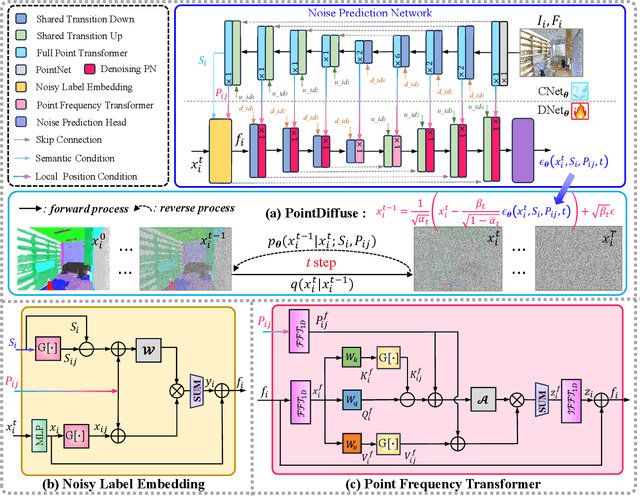

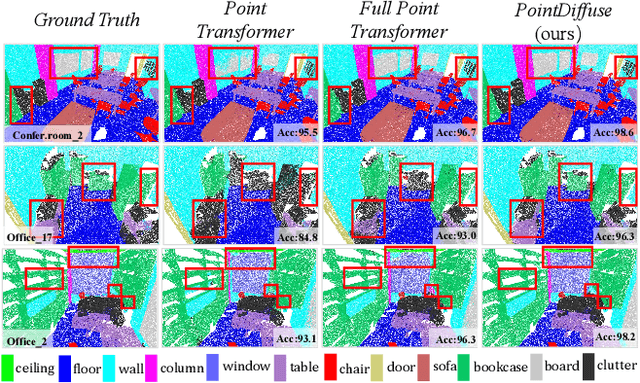

Abstract:Diffusion probabilistic models are traditionally used to generate colors at fixed pixel positions in 2D images. Building on this, we extend diffusion models to point cloud semantic segmentation, where point positions also remain fixed, and the diffusion model generates point labels instead of colors. To accelerate the denoising process in reverse diffusion, we introduce a noisy label embedding mechanism. This approach integrates semantic information into the noisy label, providing an initial semantic reference that improves the reverse diffusion efficiency. Additionally, we propose a point frequency transformer that enhances the adjustment of high-level context in point clouds. To reduce computational complexity, we introduce the position condition into MLP and propose denoising PointNet to process the high-resolution point cloud without sacrificing geometric details. Finally, we integrate the proposed noisy label embedding, point frequency transformer and denoising PointNet in our proposed dual conditional diffusion model-based network (PointDiffuse) to perform large-scale point cloud semantic segmentation. Extensive experiments on five benchmarks demonstrate the superiority of PointDiffuse, achieving the state-of-the-art mIoU of 74.2\% on S3DIS Area 5, 81.2\% on S3DIS 6-fold and 64.8\% on SWAN dataset.
A Lightweight Model for Perceptual Image Compression via Implicit Priors
Feb 19, 2025Abstract:Perceptual image compression has shown strong potential for producing visually appealing results at low bitrates, surpassing classical standards and pixel-wise distortion-oriented neural methods. However, existing methods typically improve compression performance by incorporating explicit semantic priors, such as segmentation maps and textual features, into the encoder or decoder, which increases model complexity by adding parameters and floating-point operations. This limits the model's practicality, as image compression often occurs on resource-limited mobile devices. To alleviate this problem, we propose a lightweight perceptual Image Compression method using Implicit Semantic Priors (ICISP). We first develop an enhanced visual state space block that exploits local and global spatial dependencies to reduce redundancy. Since different frequency information contributes unequally to compression, we develop a frequency decomposition modulation block to adaptively preserve or reduce the low-frequency and high-frequency information. We establish the above blocks as the main modules of the encoder-decoder, and to further improve the perceptual quality of the reconstructed images, we develop a semantic-informed discriminator that uses implicit semantic priors from a pretrained DINOv2 encoder. Experiments on popular benchmarks show that our method achieves competitive compression performance and has significantly fewer network parameters and floating point operations than the existing state-of-the-art.
RDD4D: 4D Attention-Guided Road Damage Detection And Classification
Jan 06, 2025Abstract:Road damage detection and assessment are crucial components of infrastructure maintenance. However, current methods often struggle with detecting multiple types of road damage in a single image, particularly at varying scales. This is due to the lack of road datasets with various damage types having varying scales. To overcome this deficiency, first, we present a novel dataset called Diverse Road Damage Dataset (DRDD) for road damage detection that captures the diverse road damage types in individual images, addressing a crucial gap in existing datasets. Then, we provide our model, RDD4D, that exploits Attention4D blocks, enabling better feature refinement across multiple scales. The Attention4D module processes feature maps through an attention mechanism combining positional encoding and "Talking Head" components to capture local and global contextual information. In our comprehensive experimental analysis comparing various state-of-the-art models on our proposed, our enhanced model demonstrated superior performance in detecting large-sized road cracks with an Average Precision (AP) of 0.458 and maintained competitive performance with an overall AP of 0.445. Moreover, we also provide results on the CrackTinyNet dataset; our model achieved around a 0.21 increase in performance. The code, model weights, dataset, and our results are available on \href{https://github.com/msaqib17/Road_Damage_Detection}{https://github.com/msaqib17/Road\_Damage\_Detection}.
NumGrad-Pull: Numerical Gradient Guided Tri-plane Representation for Surface Reconstruction from Point Clouds
Nov 26, 2024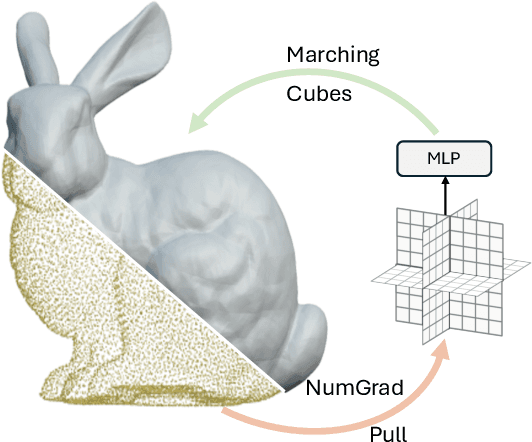

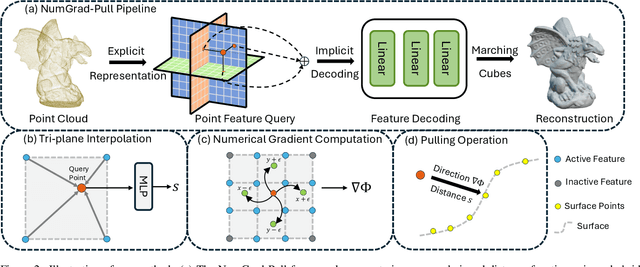

Abstract:Reconstructing continuous surfaces from unoriented and unordered 3D points is a fundamental challenge in computer vision and graphics. Recent advancements address this problem by training neural signed distance functions to pull 3D location queries to their closest points on a surface, following the predicted signed distances and the analytical gradients computed by the network. In this paper, we introduce NumGrad-Pull, leveraging the representation capability of tri-plane structures to accelerate the learning of signed distance functions and enhance the fidelity of local details in surface reconstruction. To further improve the training stability of grid-based tri-planes, we propose to exploit numerical gradients, replacing conventional analytical computations. Additionally, we present a progressive plane expansion strategy to facilitate faster signed distance function convergence and design a data sampling strategy to mitigate reconstruction artifacts. Our extensive experiments across a variety of benchmarks demonstrate the effectiveness and robustness of our approach. Code is available at https://github.com/CuiRuikai/NumGrad-Pull
LoLI-Street: Benchmarking Low-Light Image Enhancement and Beyond
Oct 13, 2024Abstract:Low-light image enhancement (LLIE) is essential for numerous computer vision tasks, including object detection, tracking, segmentation, and scene understanding. Despite substantial research on improving low-quality images captured in underexposed conditions, clear vision remains critical for autonomous vehicles, which often struggle with low-light scenarios, signifying the need for continuous research. However, paired datasets for LLIE are scarce, particularly for street scenes, limiting the development of robust LLIE methods. Despite using advanced transformers and/or diffusion-based models, current LLIE methods struggle in real-world low-light conditions and lack training on street-scene datasets, limiting their effectiveness for autonomous vehicles. To bridge these gaps, we introduce a new dataset LoLI-Street (Low-Light Images of Streets) with 33k paired low-light and well-exposed images from street scenes in developed cities, covering 19k object classes for object detection. LoLI-Street dataset also features 1,000 real low-light test images for testing LLIE models under real-life conditions. Furthermore, we propose a transformer and diffusion-based LLIE model named "TriFuse". Leveraging the LoLI-Street dataset, we train and evaluate our TriFuse and SOTA models to benchmark on our dataset. Comparing various models, our dataset's generalization feasibility is evident in testing across different mainstream datasets by significantly enhancing images and object detection for practical applications in autonomous driving and surveillance systems. The complete code and dataset is available on https://github.com/tanvirnwu/TriFuse.
Cefdet: Cognitive Effectiveness Network Based on Fuzzy Inference for Action Detection
Oct 08, 2024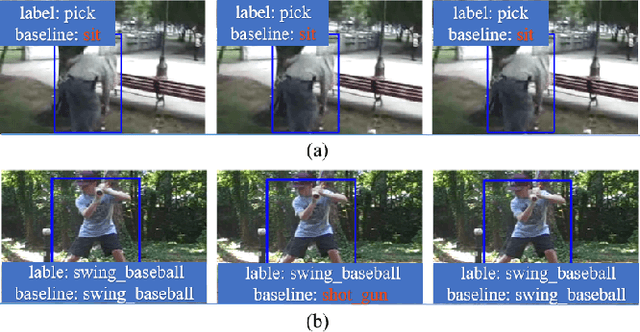
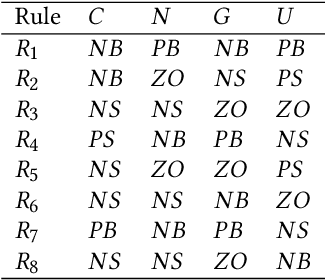
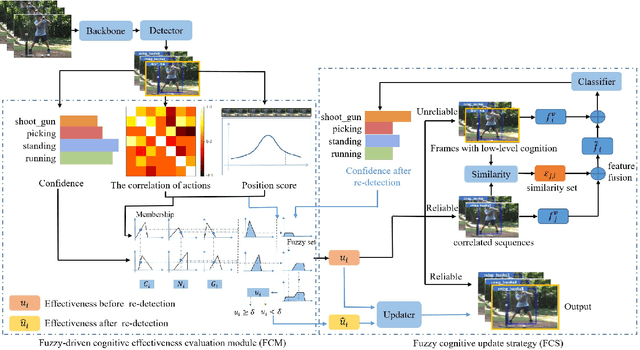
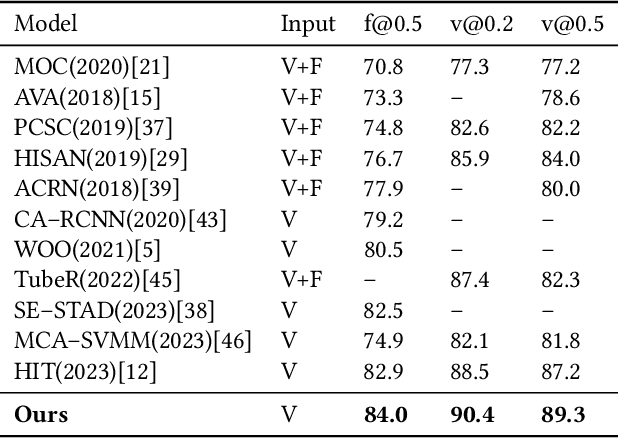
Abstract:Action detection and understanding provide the foundation for the generation and interaction of multimedia content. However, existing methods mainly focus on constructing complex relational inference networks, overlooking the judgment of detection effectiveness. Moreover, these methods frequently generate detection results with cognitive abnormalities. To solve the above problems, this study proposes a cognitive effectiveness network based on fuzzy inference (Cefdet), which introduces the concept of "cognition-based detection" to simulate human cognition. First, a fuzzy-driven cognitive effectiveness evaluation module (FCM) is established to introduce fuzzy inference into action detection. FCM is combined with human action features to simulate the cognition-based detection process, which clearly locates the position of frames with cognitive abnormalities. Then, a fuzzy cognitive update strategy (FCS) is proposed based on the FCM, which utilizes fuzzy logic to re-detect the cognition-based detection results and effectively update the results with cognitive abnormalities. Experimental results demonstrate that Cefdet exhibits superior performance against several mainstream algorithms on the public datasets, validating its effectiveness and superiority.
HazeSpace2M: A Dataset for Haze Aware Single Image Dehazing
Sep 25, 2024


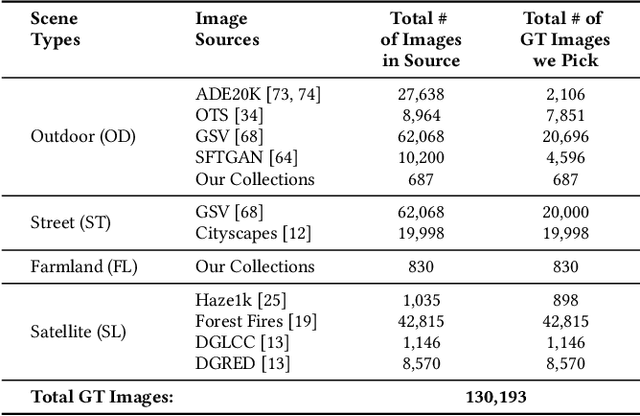
Abstract:Reducing the atmospheric haze and enhancing image clarity is crucial for computer vision applications. The lack of real-life hazy ground truth images necessitates synthetic datasets, which often lack diverse haze types, impeding effective haze type classification and dehazing algorithm selection. This research introduces the HazeSpace2M dataset, a collection of over 2 million images designed to enhance dehazing through haze type classification. HazeSpace2M includes diverse scenes with 10 haze intensity levels, featuring Fog, Cloud, and Environmental Haze (EH). Using the dataset, we introduce a technique of haze type classification followed by specialized dehazers to clear hazy images. Unlike conventional methods, our approach classifies haze types before applying type-specific dehazing, improving clarity in real-life hazy images. Benchmarking with state-of-the-art (SOTA) models, ResNet50 and AlexNet achieve 92.75\% and 92.50\% accuracy, respectively, against existing synthetic datasets. However, these models achieve only 80% and 70% accuracy, respectively, against our Real Hazy Testset (RHT), highlighting the challenging nature of our HazeSpace2M dataset. Additional experiments show that haze type classification followed by specialized dehazing improves results by 2.41% in PSNR, 17.14% in SSIM, and 10.2\% in MSE over general dehazers. Moreover, when testing with SOTA dehazing models, we found that applying our proposed framework significantly improves their performance. These results underscore the significance of HazeSpace2M and our proposed framework in addressing atmospheric haze in multimedia processing. Complete code and dataset is available on \href{https://github.com/tanvirnwu/HazeSpace2M} {\textcolor{blue}{\textbf{GitHub}}}.
* Accepted by ACM Multimedia 2024
Attention Down-Sampling Transformer, Relative Ranking and Self-Consistency for Blind Image Quality Assessment
Sep 11, 2024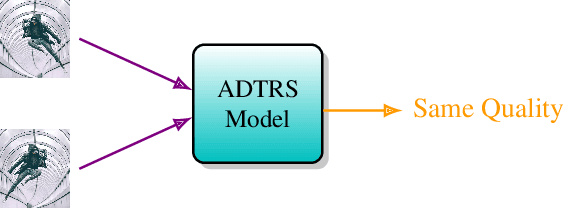
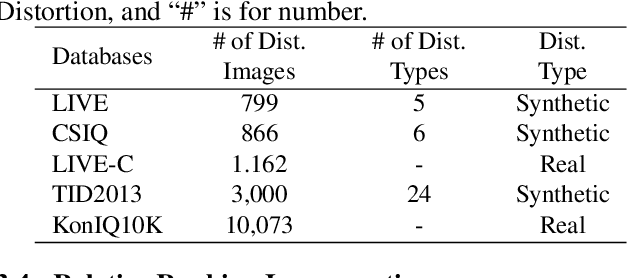
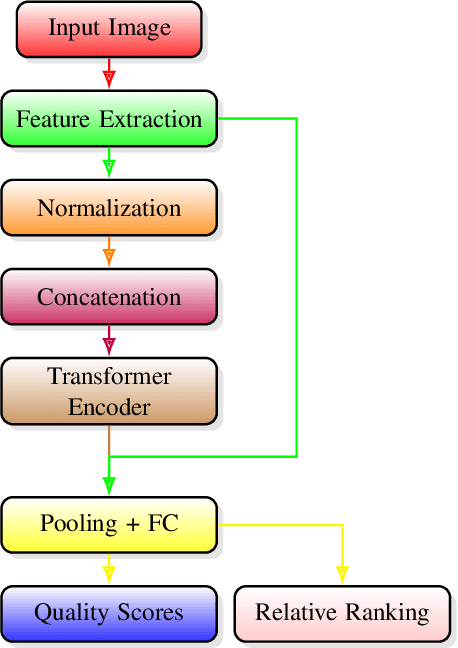
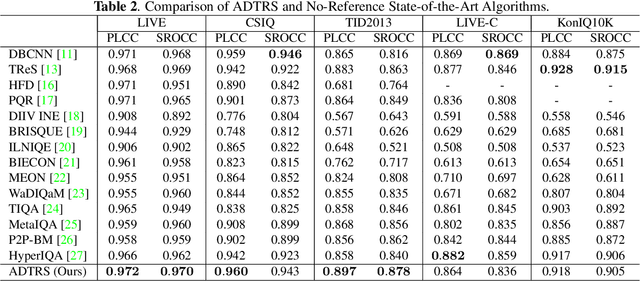
Abstract:The no-reference image quality assessment is a challenging domain that addresses estimating image quality without the original reference. We introduce an improved mechanism to extract local and non-local information from images via different transformer encoders and CNNs. The utilization of Transformer encoders aims to mitigate locality bias and generate a non-local representation by sequentially processing CNN features, which inherently capture local visual structures. Establishing a stronger connection between subjective and objective assessments is achieved through sorting within batches of images based on relative distance information. A self-consistency approach to self-supervision is presented, explicitly addressing the degradation of no-reference image quality assessment (NR-IQA) models under equivariant transformations. Our approach ensures model robustness by maintaining consistency between an image and its horizontally flipped equivalent. Through empirical evaluation of five popular image quality assessment datasets, the proposed model outperforms alternative algorithms in the context of no-reference image quality assessment datasets, especially on smaller datasets. Codes are available at \href{https://github.com/mas94/ADTRS}{https://github.com/mas94/ADTRS}
 Add to Chrome
Add to Chrome Add to Firefox
Add to Firefox Add to Edge
Add to Edge